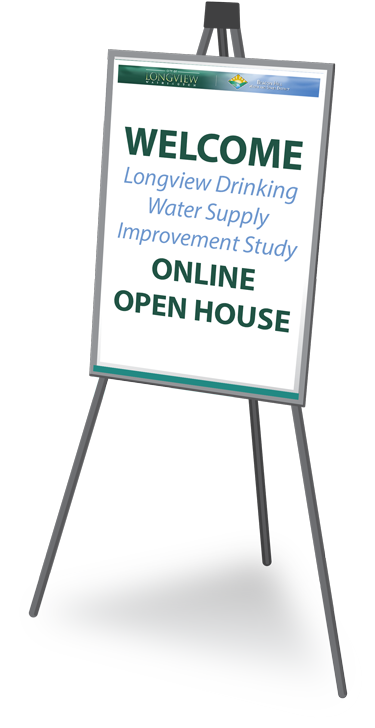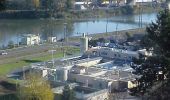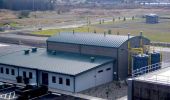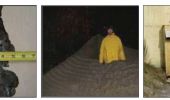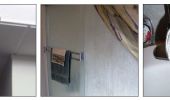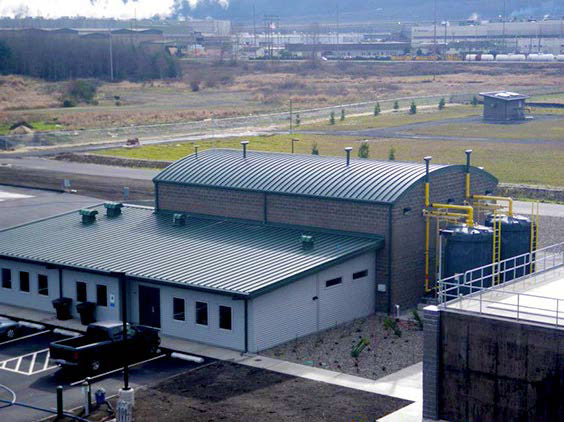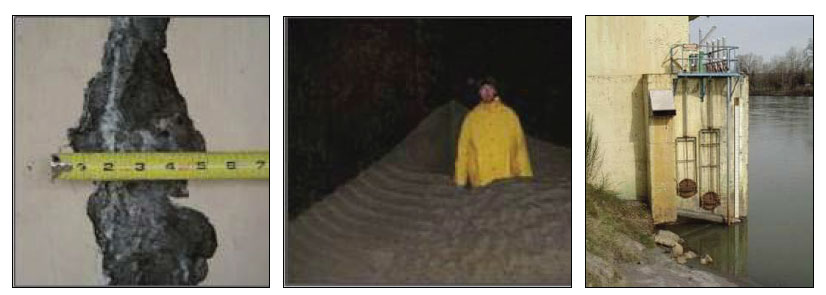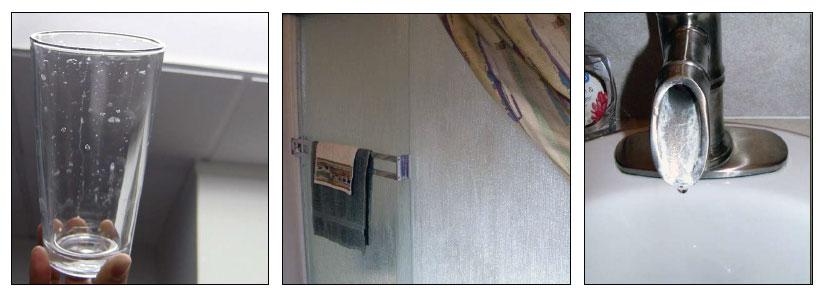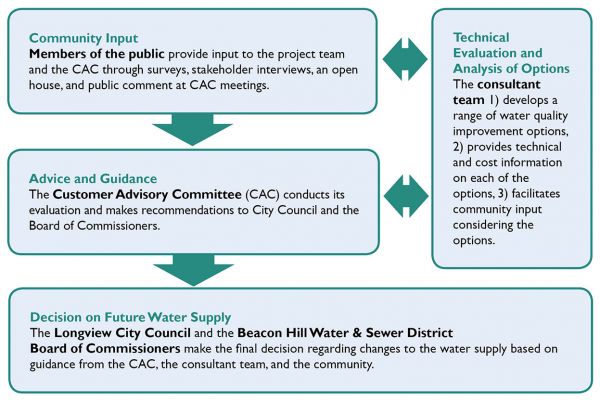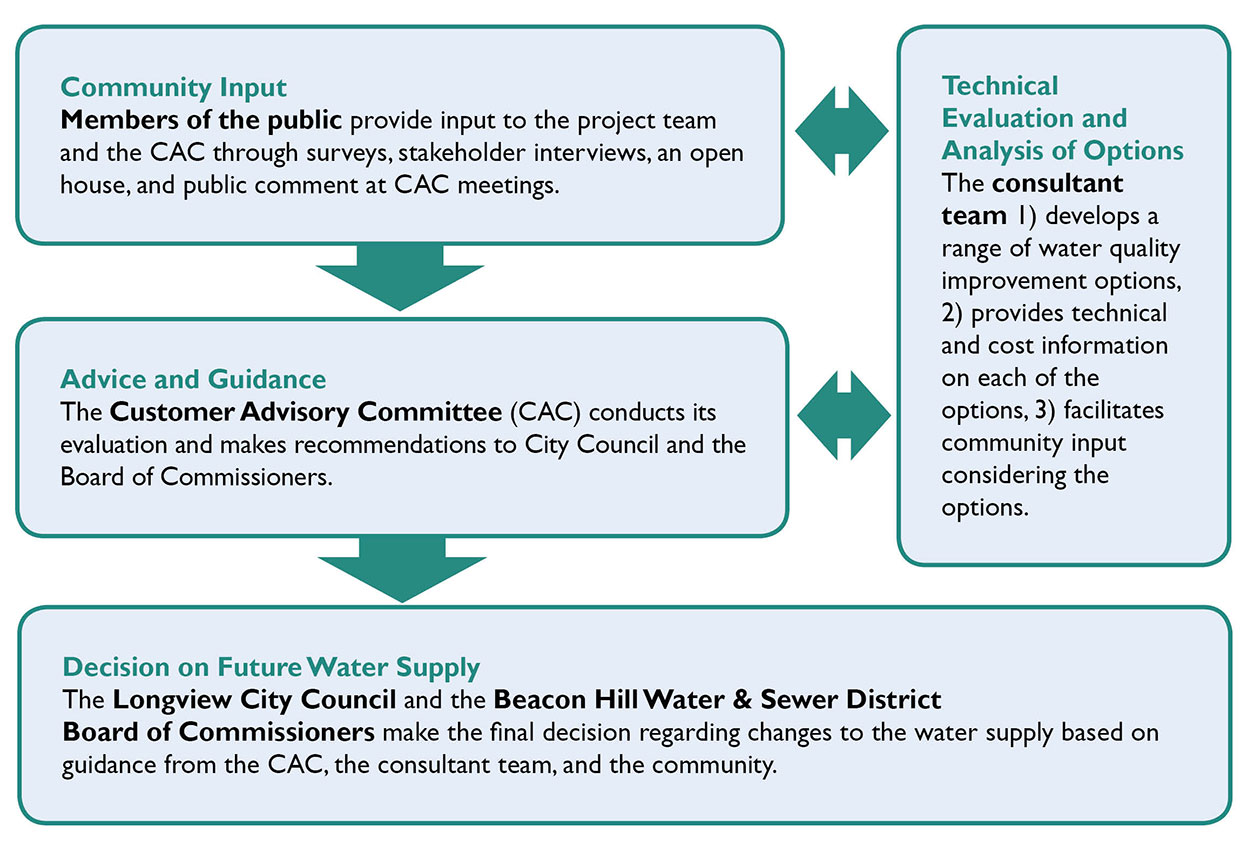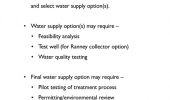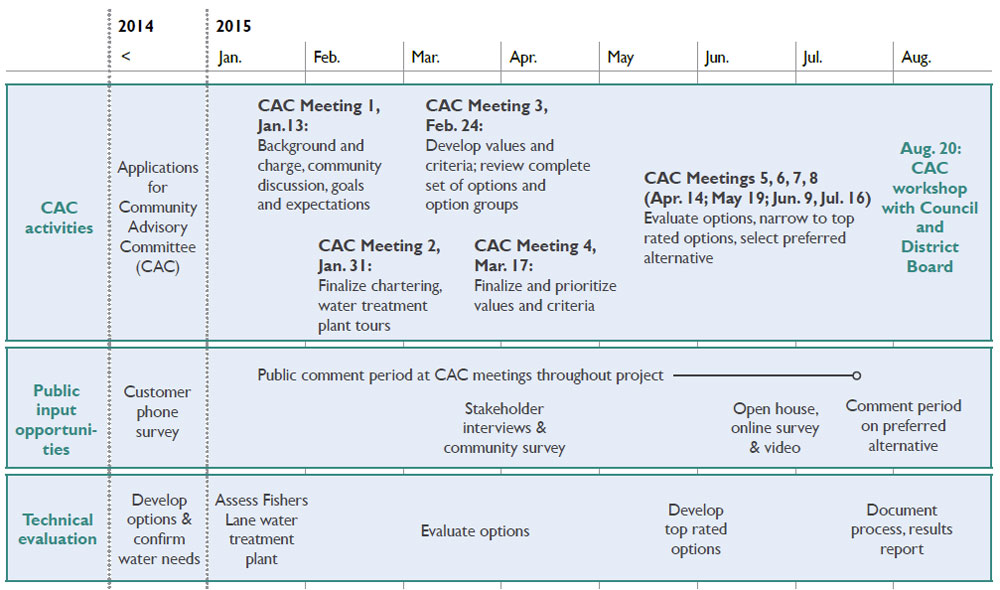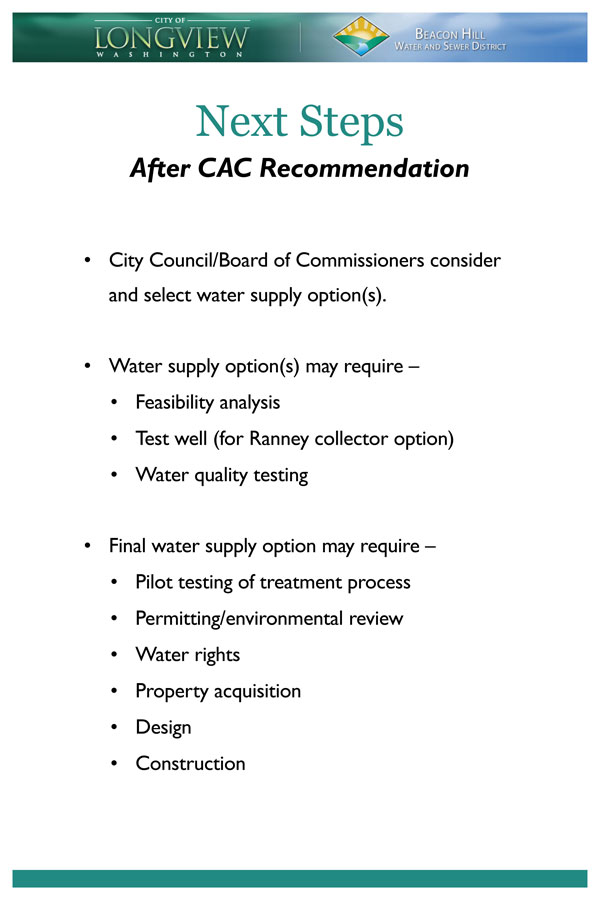This interactive tool includes a series of stations where you can learn more about the study and provide feedback. Thank you for participating.
Study Information
Open House Stations
The first pages provide information about the study. You will then have the opportunity to indicate which water supply options are acceptable and to rank the water supply options you prefer.
It will likely take about 10 minutes to work through the open house and survey questions. You will need to submit your answers before leaving for them to be logged.
2013 Change to Water Supply
In 2013, the water supply was switched from a surface water source on the Cowlitz River to a groundwater source from the Mint Farm wellfield.
Why change the water supply?
The Fishers Lane Water Treatment Plant, built in 1946, was failing and needed extensive upgrades that were estimated to cost nearly $53 million.
- Summer water demands regularly exceeded plant capacity and increased water supply was needed for future growth.
- Cowlitz River sediment was causing major equipment problems.
- The water intake structure required significant improvements to meet fish protection regulations.
What options were considered?
Over the course of years, extensive analysis and testing of possible surface and groundwater sources was performed. Ten primary options were considered. During the process, the community was kept informed via newsletters, open houses, bill inserts, videos, public service announcements, newspaper articles and City Council meetings and workshops.
How much did it cost?
The total cost to design and build the new Mint Farm groundwater source was $34 million.
Customer Disatisfaction
While the new system provides water that meets all water safety and quality standards, an October 2014 survey found that a large majority of water users (82%) are dissatisfied with their water.
Average Customer Water Quality Rating
During the survey, customers ranked their water quality on a 10-point scale, with 10 being very good and 1 being very poor. The average rankings were:
- Longview: 4.3
- Beacon Hill: 4.9
Common Water Quality Concerns
The most common issues expressed by water customers include:
- Spots and residue
- Bad taste
- Color and staining
- Smell
- Indirect costs to customers, including damage to appliances and buying bottled water
- Fear of health impacts
More Information on Water Quality Concerns
Spotting and mineral buildup on appliances and fixtures
- The groundwater supply has higher dissolved silica and hardness than the Cowlitz River.
Taste, odor, and color
- Dissolving iron and manganese scale in the pipes may cause metallic taste and odor, and orange/red/black discoloration.
- Bio-film presence and sloughing in homeowners’ plumbing may cause musty taste and odor, and black slime.
- Organic nitrogen reacting with chlorine contributes to bitter taste and chlorine odor.
- Loss of chlorine in homeowners’ water heaters may lead to rotten egg odors due to low levels of sulfides.
Skin rashes, upset stomachs and other ailments
- Higher hardness levels in the groundwater may cause itching, dryness, rashes, and other reactions reported by customers.
- Customers have reported concerns about safety of the water – the water is routinely tested and meets water quality standards; however, customer complaints are being taken seriously and considered in the study.
Study Process Flowchart
Decision-Making Process
The City Council and BHWSD are responsible for making the final decision regarding changes to the water supply. However, the CAC plays a key role in recommending a preferred course of action. All parts of the study process will be informed by technical information from the consultant team and feedback from the community.
Evaluation Criteria
Evaluation criteria were developed to guide the CAC recommendation process. The criteria are grouped under three key values:
- Key Value #1: Improve customer perception about the water supply with respect to it being high quality and having no toxic risk. Includes taste, smell, spotting and health concerns.
- Key Value #2: The recommendation should be technically feasible and have long-term viability. Includes long-term capacity, reliability, operability and permitting considerations.
- Key Value #3: Consider the cost and affordability of water, both in terms of rates and indirect costs to customers for bottled water, appliance repair, in-home treatment or other similar costs.
Water Supply Alternatives
From an initial list of more than 50 options, the CAC selected preferred options based on the key values. At their last meeting, the CAC chose two options they consider to be the best. The alternatives have been grouped by source on the following pages. Tabs provide information about the different supply options and how they each compare against the three key values.
Costs provided are rough estimates. While it is difficult to estimate costs at these very preliminary stages, these estimates are intended to allow for comparison among the various options. Cost ranges represent the variations among specific options within each cluster.
Groundwater comes from underground aquifers tapped by wells. Groundwater is generally safer than surface water and requires less treatment but often has higher levels of dissolved minerals, silica and hardness, which cause many of the current complaints about taste, smell, color and spotting with Longview’s drinking water. The public has also expressed concern regarding the proximity of the Mint Farm wells to former and current industrial sites.
Several options to modify the current Mint Farm wells and treatment process have been considered, each of which would address concerns differently:
Modified Treatment (Mint Farm Wells)
About this option
This option would involve modifying existing treatment by adding one or more processes to soften the water, remove silica, and/or change other water chemistry.
Addressing Key Values
- Customer Perception: Some treatment technologies could address spotting, purity, taste, color, and odor issues; however, it’s unclear whether this option would address health concerns.
- Technical Feasibility / Long-Term Viability:
- Most technologies would meet the capacity, reliability, permitting and operating requirements.
- Treatment modifications could be completed within 3 years.
- Addtional Cost: $1 to $25 per month increase
Modified Distribution System (Mint Farm Wells)
About this option
This option would involve adding treatment of water in the distribution system, changing direction of flow in portions of the distribution system, and/or replacing pipes in the distribution system.
Addressing Key Values
- Customer Perception: May improve taste, color, and odor issues. Would not address concerns related to spotting (from silica), purity, or general health.
- Technical Feasibility / Long-Term Viability:
- Meets long-term capacity, reliability, permitting and operating requirements.
- Treatment modifications could be completed within 3 years; distribution system replacement would be phased over 20 years.
- Additional Cost: $1 to $70 per month increase
Surface Water Source (Cowlitz) - CAC preferred option
About this option
Surface water would be drawn directly from the Cowlitz River. Surface water generally has lower levels of minerals, silica and hardness, but can present technical challenges such as high levels of silt, more expensive treatment, and environmental permitting requirements.
Addressing Key Values
- Customer Perception: Addresses concerns related to taste, odor, color, spotting, purity and general health - because surface water generally has lower levels of minerals, silica and hardness.
- Technical Feasibility / Long-Term Viability:
- Meets long-term capacity, reliability and operating requirements. Permitting will be difficult.
- Would take approximately 5 years to complete.
- Additional Cost: $15 to $47 per month increase
Ranney Collector (Cowlitz) - CAC preferred option
About this option
A Ranney collector is a well used to extract water from an aquifer with direct connection to a surface water source - in this case, the Cowlitz River. The purpose of a Ranney collector would be to obtain water quality similar to surface water, but without the regulations and technical difficulties associated with directly withdrawing water from the river.
Addressing Key Values
- Customer Perception: Addresses concerns related to taste, odor, color, spotting, purity and general health.
- Technical Feasibility / Long-Term Viability:
- More analysis is needed to determine if this would meet long-term capacity and reliability requirements.
- Would take up to 3 years to complete.
- Additional Cost: $10 to $24 per month increase
Aquifer Storage and Recovery (Cowlitz)
About this option
Aquifer Storage and Recovery (ASR) is the injection of potable water into an aquifer for later recovery and use (for example, surface water may be injected into an aquifer during the winter and withdrawn during the summer during high demand). The purpose of this option would be to obtain surface water quality but avoid complications, such as regulations around when surface water can be withdrawn from the river.
This option would use water from the Cowlitz River as a source and the Mint Farm well field as a storage aquifer.
Addressing Key Values
- Customer Perception: Would improve issues related to taste, odor, color, and spotting. May not fully address water quality concerns because ASR water would be stored in the aquifers currently in use and may absorb some of the minerals.
- Technical Feasibility / Long-Term Viability:
- More analysis is needed to determine if this would meet long-term capacity and reliability requirements. Permitting a surface withdrawal will be difficult.
- Could take up to 5 years to complete.
- Additional Cost: $8 to $15 per month increase
Blending Surface or Ranney Collector Water with Groundwater (Cowlitz)
About this option
This option would involve mixing water from the Cowlitz River with groundwater from the Mint Farm wellfield. This would improve water quality at a lower cost to rate payers compared to completely replacing the Mint Farm wellfield source.
Addressing Key Values
- Customer Perception: Would improve issues related to taste, odor, color, and spotting. May not fully address water quality concerns because the current groundwater would continue to be used.
- Technical Feasibility / Long-Term Viability:
- More analysis is needed to determine if this option would meet long-term capacity and reliability requirements. Permitting will be difficult.
- Could take up to 5 years to complete.
- Additional Cost: $21 per month increase
New Surface Water Source (Columbia)
About this option
Surface water would be drawn directly from the Columbia River. Surface water generally has lower levels of minerals, silica and hardness, but can present technical challenges such as high levels of silt, more expensive treatment, and environmental permitting requirements.
Addressing Key Values
- Customer Perception: Addresses concerns related to taste, odor, color and spotting - because surface water generally has lower levels of minerals, silica and hardness. Members of the CAC have expressed concern regarding purity and general health issues.
- Technical Feasibility / Long-Term Viability:
- Meets long-term capacity, reliability and operating requirements. Permitting will be difficult.
- Would take approximately 5 years to complete.
- Additional Cost: $15 to $37 per month increase
Ranney Collector (Columbia)
About this option
A Ranney collector is a well used to extract water from an aquifer with direct connection to a surface water source - in this case, the Columbia River. The purpose of a Ranney collector would be to obtain water quality similar to surface water, but without the regulations and technical difficulties associated with directly withdrawing water from the river.
Addressing Key Values
- Customer Perception: Addresses concerns related to taste, odor, color, and spotting. CAC members have expressed concern regarding purity and general health issues.
- Technical Feasibility / Long-Term Viability:
- More analysis is needed to determine if this option would meet long-term capacity and reliability requirements.
- Would take up to 3 years to complete.
- Additional Cost: $10 to $27 per month increase
Aquifer Storage and Recovery (Columbia)
About this option
Aquifer Storage and Recovery (ASR) is the injection of potable water into an aquifer for later recovery and use (for example, surface water may be injected into an aquifer during the winter and withdrawn during the summer during high demand). The purpose of this option would be to obtain surface water quality but avoid complications, such as regulations around when surface water can be withdrawn from the river.
This option would use water from the Columbia River as a source and the Mint Farm well field as a storage aquifer.
Addressing Key Values
- Customer Perception: Would improve issues related to taste, odor, color, and spotting. May not fully address water quality concerns because ASR water would be stored in the aquifers currently in use and may absorb some of the minerals. CAC members have expressed concern regarding purity and general health issues related to Columbia River water.
- Technical Feasibility / Long-Term Viability:
- More analysis is needed to determine if this option would meet long-term capacity and reliability requirements. Permitting a surface withdrawal will be difficult.
- Could take up to 5 years to complete.
- Additional Cost: $8 to $24 per month increase
Blending Surface or Ranney Collector Water with Groundwater (Columbia)
About this option
This option would involve mixing Columbia River water with groundwater from the Mint Farm wellfield. This would improve water quality at a lower cost to rate payers compared to completely replacing the Mint Farm wellfield source.
Addressing Key Values
- Customer Perception: Would improve issues related to taste, odor, color, and spotting. May not fully address water quality concerns because the current groundwater would continue to be used. CAC members have expressed concern regarding purity and general health issues related to Columbia River water.
- Technical Feasibility / Long-Term Viability:
- More analysis is needed to determine if this option would meet long-term capacity and reliability requirements. Permitting will be difficult.
- Could take up to 5 years to complete.
- Additional Cost: $20 per month increase
New Well Field
About this option
Groundwater comes from underground aquifers tapped by wells. Groundwater is generally safer than surface water and requires less treatment but often has higher levels of dissolved minerals, silica and hardness, which cause many of the current complaints about taste, smell, color and spotting with Longview’s drinking water.
This option involves switching to a new groundwater source (other than Mint Farm), but requires more study to determine if the new water quality would be better than existing.
Addressing Key Values
- Customer Perception: More analysis is needed to determine whether this option would address concerns related to spotting, taste, smell, purity or general health concerns.
- Technical Feasibility / Long-Term Viability: More analysis is needed to know whether this would be technically viable and to determine the time required to complete.
- Additional Cost: $7 per month increase
New Surface Water Source (Other)
About this option
Surface water would be drawn directly from a new upland water source, either with a surface dam and treatment at that location or with water conveyed to an existing treatment plant in an open channel. Surface water options generally have lower levels of minerals, silica and hardness, but can present technical challenges such as high levels of silt, more expensive treatment, and environmental permitting requirements.
Addressing Key Values
- Customer Perception: More analysis is needed to determine if this option would address concerns related to taste, odor, color, spotting, purity and general health.
- Technical Feasibility / Long-Term Viability: More analysis is needed to determine if this option would meet long-term capacity and reliability requirements and to determine the time required to complete.
- Additional Cost: $55 to $64 per month increase
Ranney Collector (Kalama)
About this option
A Ranney collector is a well used to extract water from an aquifer with direct connection to a surface water source - in this case, the Kalama River. The purpose of a Ranney collector would be to obtain water quality similar to surface water, but without the regulations and technical difficulties associated with directly withdrawing water from the river.
Addressing Key Values
- Customer Perception: Addresses concerns related to taste, odor, color, spotting, purity and general health.
- Technical Feasibility / Long-Term Viability:
- More analysis is needed to determine if this option would meet long-term capacity and reliability requirements.
- Would take up to 3 years to complete.
- Additional Cost: $14 per month increase
Below is a list of water supply options that you said are "acceptable" on the previous pages. Please help us understand your order of prefence by dragging and arranging the options into the green box. (Place your highest priority options at the top.)
Preferred water supply options:
- Status Quo (Mint Farm Wells)
- Modified Treatment (Mint Farm Wells)
- Modified Distribution System (Mint Farm Wells)
- Surface Water Source (Cowlitz) - CAC Preferred Option
- Ranney Collector (Cowlitz) - CAC Preferred Option
- Aquifer Storage and Recovery (Cowlitz)
- Blending Surface Water with Groundwater (Cowlitz)
- New Surface Water Source (Columbia)
- Ranney Collector (Columbia)
- Aquifer Storage and Recovery (Columbia)
- Blending Surface Water with Groundwater (Columbia)
- New Well Field
- New Surface Water Source (Other)
- Ranney Collector (Kalama)
You have not rated any options as "acceptable" yet.
Final Questions
Before you leave, be sure to submit any comments you've provided by hitting the button at the bottom of this page.
The CAC selected preferred water supply improvement options that are estimated to take as many as 3 to 5 years to complete. During that transition time, drinking water quality would not be expected to improve noticeably. Some interim modifications to the Mint Farm treatment process could have relatively low cost to rate payers and may provide some improvement to water quality in regards to taste, color and odor during the transition period.
If the CAC recommends development of a new water supply, would you want the CAC to also recommend interim treatment modifications to improve water quality during the transition time?
(Check one.)Email List Signup
To Stay Involved
- Visit the project website to get the latest study updates: www.longviewwater.org
- E-mail Adrienne DeDona at adrienne@jla.us.com.
Before you leave, be sure to submit any comments you've provided.
